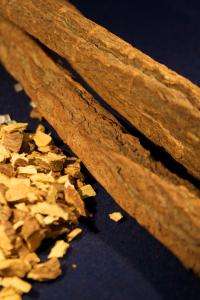Inside a plant's pharma factory

A newly discovered enzyme brings scientists one step closer to understanding how plants manufacture a molecule with potent medicinal properties.
Plants of the genus Glycyrrhiza are best known as key ingredients in the popular treat licorice, but they also have a valuable place in the medicine cabinet (Fig. 1). These plants employ a complex assembly line of enzymes to produce a molecule called glycyrrhizin, a potent sweetener that also acts as a highly effective anti-inflammatory and antiviral agent.
The process of glycyrrhizin biosynthesis is incompletely understood, but research from a team led by Kazuki Saito and Toshiyuki Muranaka at the RIKEN Plant Science Center in Yokohama helps to fill some of the gaps. According to Saito, these efforts depended on close collaboration between multiple research teams. Members of the ‘All-Japan Licorice Research Consortium’, pooled their research resources, which was the strong basis for the success of this project, according to Saito.
The researchers were particularly interested in enzymes known as cytochrome P450 mono-oxygenases. For a previous study, they prepared a large library of gene sequences expressed by Glycyrrhiza to identify previously uncharacterized P450s. This time around, Saito and Muranaka performed a functional assay in which they expressed several of these putative P450s in cultured cells so they could identify enzymes that act on specific intermediates in glycyrrhizin manufacture.
They identified one protein, CYP72A154, which recognized the early glycyrrhizin intermediate 11-oxo-β-amyrin as a substrate. Remarkably, this enzyme appears to perform multiple sequential oxidation reactions on this compound, effectively moving the synthetic process forward three steps. To confirm these findings, they tested the function of CYP72A154 by co-expressing it alongside other enzymes known to participate in this biological process. “We achieved biotechnological production of glycyrrhetinic acid, an intermediate of glycyrrhizin, by means of synthetic biology in yeast,” says Muranaka.
This demonstration of partial glycyrrhizin biosynthesis represents an important step in the right direction: even though this valuable molecule is easily purified from licorice plants, scientists may ultimately find themselves forced to resort to laboratory production methods. “There is a potential risk of a shortage of natural resources in the near future,” says Saito. “Another problem is that China, the dominant supplier of licorice, is setting restrictions on licorice exports as a governmental policy.”
Several pieces are still missing from the puzzle, but Saito and Muranaka are excited to learn what remains to be found, both from a biotechnology perspective and in terms of understanding aspects of plant evolutionary history. “We still don’t know why and how higher plants have evolved the production systems for such interesting compounds,” says Muranaka.
More information: Seki, H., et al. Triterpene functional genomics in licorice for identification of CYP72A154 involved in the biosynthesis of glycyrrhizin. Plant Cell 23, 4112–4123 (2011).
Seki, H., et al. Licorice β-amyrin 11-oxidase, a cytochrome P450 with a key role in the biosynthesis of the triterpene sweetener glycyrrhizin. Proceedings of the National Academy of Sciences USA 105, 14204–14209 (2008).
Provided by RIKEN


















